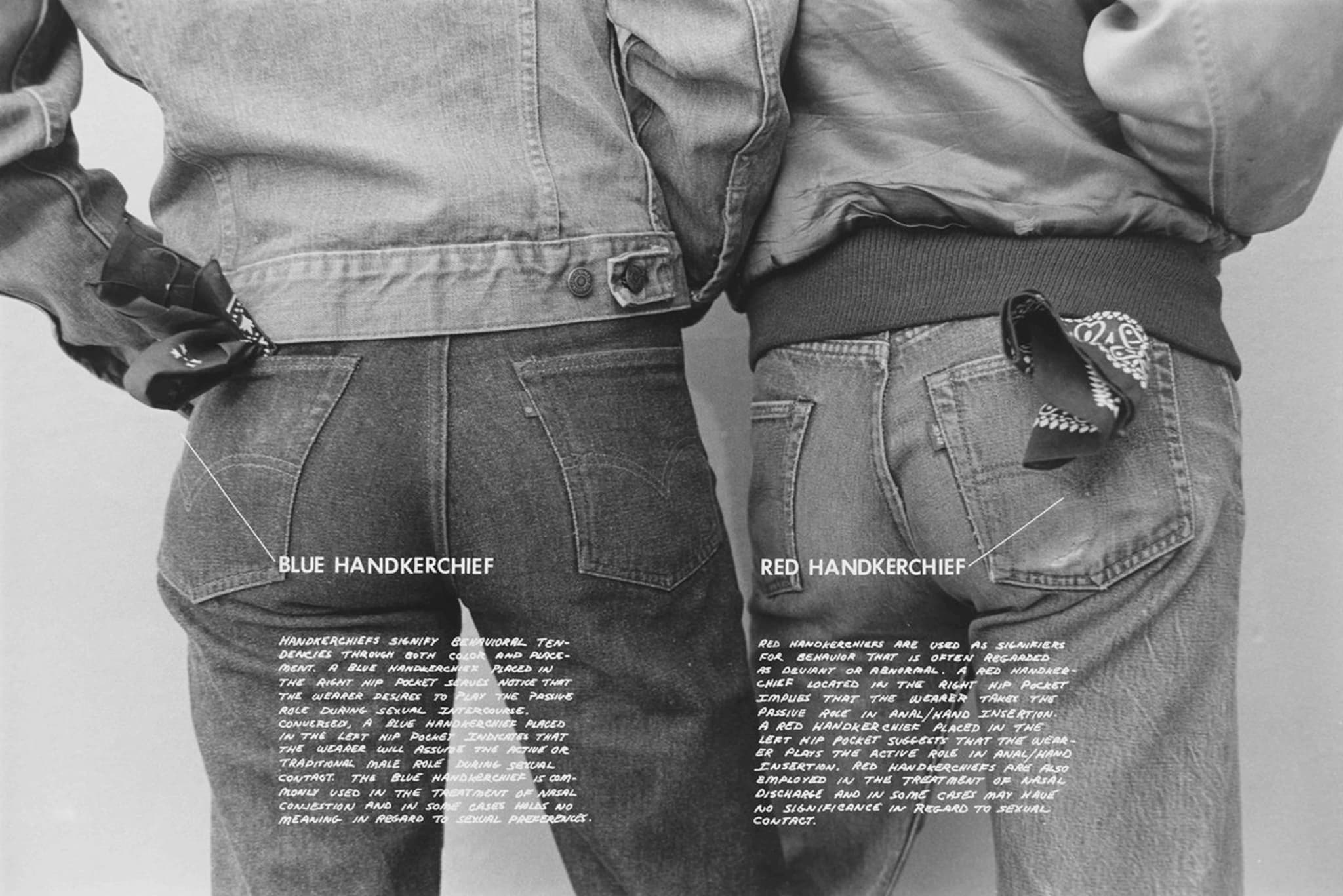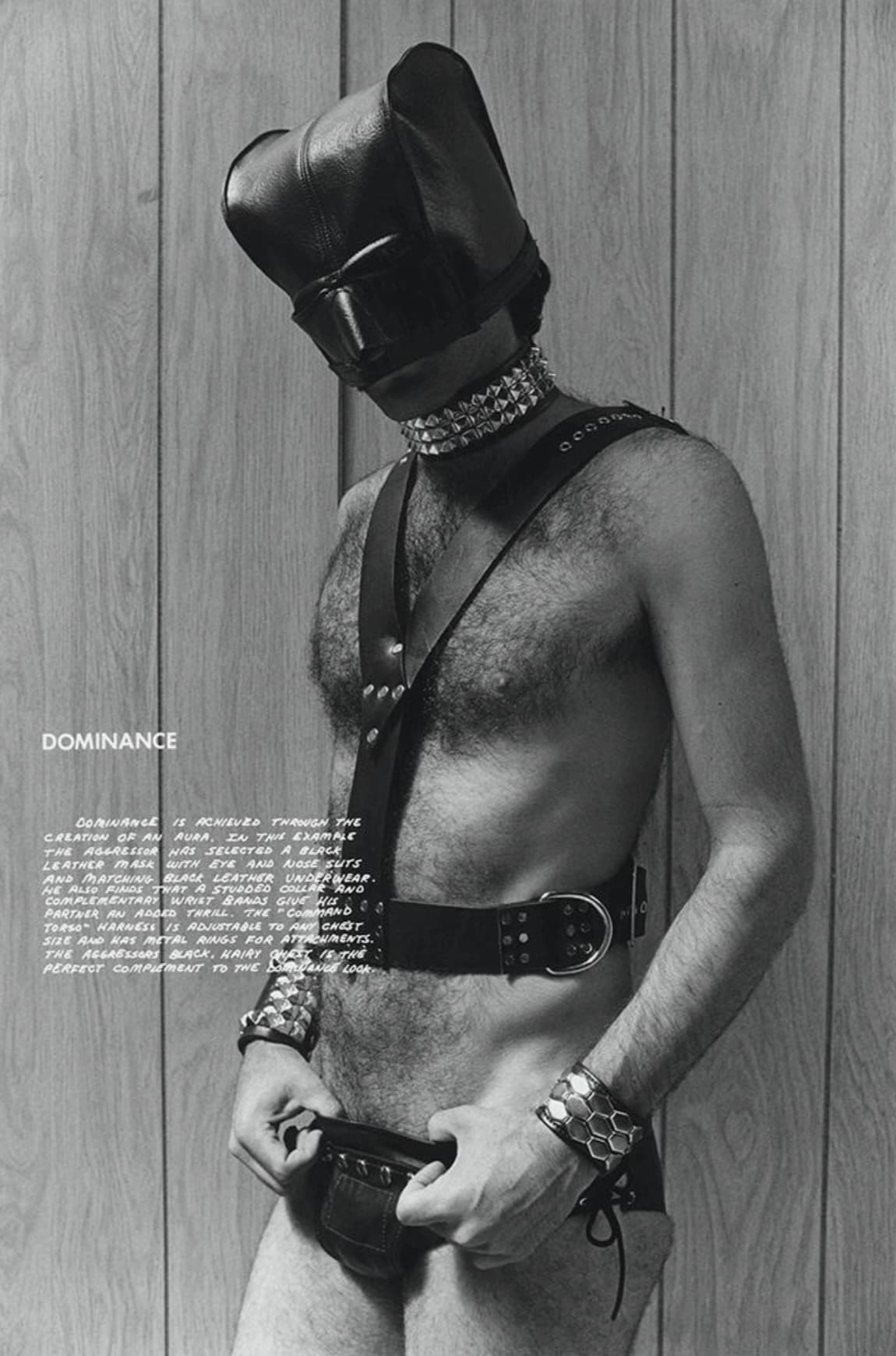Sex Symbols: What Does A Blue Hankie in your Left Back Pocket Mean?
March 2017
Hal Fischer took the language of the instruction manual and applied it to the jocks and leathermen of gay San Francisco in the 70s. He explains the code.
- Hettie Judah

In one of the first photographs Hal Fischer composed for Gay Semiotics, we see two sets of male buttocks, each clad in high-cut, form-fitting Levi’s. One sports a blue bandana in the left back pocket, which, according to the overlaid text, “indicates that the wearer will assume the active or traditional male role during sexual contact”. The other has a red bandana in the right back pocket, indicating that “the wearer takes the passive role in anal/hand insertion”. But, the text cautions dryly, “red handkerchiefs are also employed in the treatment of nasal discharge and in some cases may have no significance in regard to sexual contact”.
Made in 1977, when Fischer was in his 20s, the Gay Semiotics series is a wonderfully poker-faced portrait of queer male culture in San Francisco’s Castro and Haight-Ashbury neighbourhoods at their carefree apogee. As well as deciphering the codes of hankies, key chains and earrings, Gay Semiotics guides us through archetypes, street fashions and various BDSM practices. Forty years on, the images can now be seen at Project Native Informant in London, along with other Fischer works from the 1970s.
“The work was very subversive, and I still get a kick out of that,” says Fischer, in London for the show’s opening. “I wanted people to see the photographs first, then get up close. I wanted there to be a certain innocence when they started reading, then of course there’s a little shock, and some punchlines, then people start laughing.”
For Fischer, the humour, the labels, the instructive text and the use of greyscale all served to undermine the romanticism that still surrounded photography in the US at the time. It’s a visual language borrowed from banal instruction manuals. Even the images dealing with domination are composed with a lightness of touch and salting of humour that is decidedly unmenacing. “I don’t think someone who was really into the S&M culture would be drawn to these, because they’re really too playful,” says Fischer, pointing out that in his experience, giggling is something of a mood-breaker in such situations.
It was reading Lévi-Strauss – the anthropologist, rather than the manufacturer of denims – that inspired Fischer to codify the dress and behaviour of San Francisco’s gay community. “Anthropologically, this was going on all around me: it was amazing and nobody was dealing with it like that, so I just went for it.”
Unlike the distant anthropologist, Fischer was quite literally embedded in the culture he portrayed. Fischer encountered one of his subjects hanging around outside his local cafe, and another at Gus’s Pub. The chap who posed for the Basic Gay picture “worked in the photo store down the street. It’s where you’d go on Wednesday and put in your marijuana brownie order, because then Brownie Mary – if she wasn’t in jail – would drop off the brownies on Friday.”

All the men – from the Jock in his snug satin shorts to the leatherman with a cockring on his epaulette – are sporting their regular clothes. Fischer was inspired by the German photographer August Sander’s People of the 20th Century in portraying his subjects on their own terms. “The thing that appealed to me about Sander’s work was the idea of letting the person present themselves to you. I did not tell these people what to do, what to wear or anything.”
The figures selected for inclusion are, by and large, those who Fischer was interested in looking at himself: “It is, on a certain level, a lexicon of my own desires, though maybe a little broader than that. I didn’t put in anybody in drag – and there were people in drag around. I was part of the clone group.”
The codes and dressing-up fulfilled an important function at a time when the ability to read a situation accurately was imperative: “The reality of some of this is, back in the day, if you hit on a straight man, it could have had not-good consequences.”
Shortly after completing the works on show here – which also include the 1979 project A Salesman, in which a naked man with a moustache appeared on a billboard in San Francisco’s Castro district – Fischer decided to cease working as an artist. Today his photographic output is largely restricted to iPhone snaps of his dog, Jasper – albeit in appropriately extravagant costume.
“When I had my first solo show in 1977,” he says, “the critic part of me kind of took over. I thought to myself, ‘You’ve hit the perfect moment, everything has come together. Culturally, you’re doing this at exactly the right time. Art-wise, you’re involved in something that has methodology and is conceptual. Most people don’t even get this once.’ And I’d got it.”